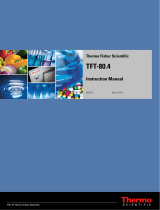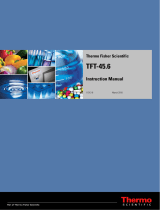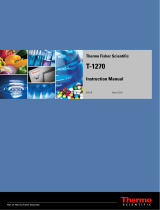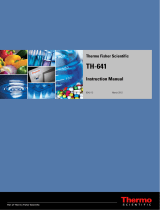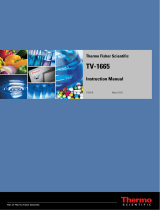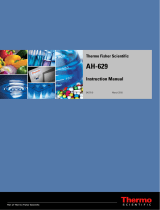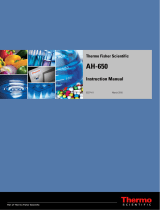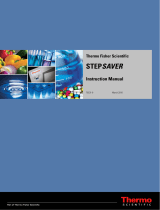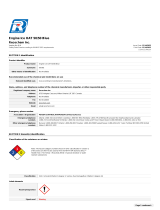Page is loading ...

54462-4 June 2011
Thermo Fisher Scientific
TFT-80.2
Instruction Manual

© 2011 Thermo Fisher Scientific Inc. All rights reserved.
All other trademarks are the property of Thermo Fisher Scientific Inc. and its subsidiaries.
Thermo Fisher Scientific
Robert-Bosch-Straße 1
D - 63505 Langenselbold
Germany
Thermo Fisher Scientific Inc. provides this document to its customers with a product purchase to use in the
product operation. This document is copyright protected and any reproduction of the whole or any part of this
document is strictly prohibited, except with the written authorization of Thermo Fisher Scientific Inc.
The contents of this document are subject to change without notice. All technical information in this
document is for reference purposes only. System configurations and specifications in this document supersede
all previous information received by the purchaser.
Thermo Fisher Scientific Inc. makes no representations that this document is complete, accurate or error-
free and assumes no responsibility and will not be liable for any errors, omissions, damage or loss that might
result from any use of this document, even if the information in the document is followed properly.
This document is not part of any sales contract between Thermo Fisher Scientific Inc. and a purchaser. This
document shall in no way govern or modify any Terms and Conditions of Sale, which Terms and Conditions of
Sale shall govern all conflicting information between the two documents.
Release history: 54462-4 printed in June 2011.
For Research Use Only. Not for use in diagnostic procedures.

Thermo Scientific TFT-80.2 i
T
Thermo Scientific TFT-80.2 Titanium Fixed-Angle Ultraspeed Centrifuge Rotor ......... ii
Important Safety Information ................................................................................................. iii
Chapter 1 DESCRIPTION ........................................................................................................................ 1-1
Rotor Description .................................................................................................... 1-2
Rotor Specifications ................................................................................................. 1-2
Accessories ............................................................................................................... 1-3
Chapter 2 OPERATION ............................................................................................................................ 2-1
Prerun Safety Checks ............................................................................................... 2-2
Ultraspeed Centrifuge Modification Requirements .................................................. 2-2
Chemical Compatibility .......................................................................................... 2-3
Compartment Loads in Excess of Design Mass ........................................................ 2-3
Critical Speed .......................................................................................................... 2-4
Rotor Precool .......................................................................................................... 2-4
Relative Centrifugal Force (RCF) Determination .................................................... 2-4
Calculation of Sedimentation Time in Aqueous (Non-gradient) Solutions .............. 2-5
Tube Filling and Sealing .......................................................................................... 2-9
Rotor Balancing ..................................................................................................... 2-11
Rotor Loading and Installation .............................................................................. 2-12
Tube Removal ....................................................................................................... 2-13
Centrifuge/Rotor Log ............................................................................................ 2-14
Chapter 1 CARE and MAINTENANCE ................................................................................................... 1-1
Corrosion ................................................................................................................ 1-2
Cleaning and Decontamination ............................................................................... 1-2
Overspeed Decal Replacement ................................................................................. 1-3
Storage ..................................................................................................................... 1-3
Service Decontamination Policy .............................................................................. 1-4
Chemical Compatibility Chart ...............................................................................A-1
Contact Information ................................................................................................B-1
Table of contents

Table of contents
ii TFT-80.2 Thermo Scientific

Thermo Scientific TFT-80.2 ii
P
This manual is a guide for the use of
Thermo Scientific TFT-80.2 Titanium Fixed-Angle
Ultraspeed Centrifuge Rotor
Data herein has been verified and is believed adequate for the intended use of the rotor. Because failure
to follow the recommendations set forth in this manual could produce personal injury or property
damage, always follow the recommendations set forth herein. Thermo Fisher Scientific does not
guarantee results and assumes no obligation for the performance of rotors or other products that are
not used in accordance with the instructions provided. This publication is not a license to operate
under, nor a recommendation to infringe upon, any process patents.
Publications prior to the Issue Date of this manual may contain data in apparent conflict with that
provided herein. Please consider all data in this manual to be the most current.
NOTES, CAUTIONS, and WARNINGS within the text of this manual are used to emphasize
important and critical instructions.
WARNING informs the operator of a hazard or unsafe practice that could result in personal injury,
affect the operator's health, or contaminate the environment.
CAUTION informs the operator of an unsafe practice that could result in damage of equipment.
NOTE highlights essential information.
© 1987, 2000, 2010 by Thermo Fisher Scientific
CAUTION and WARNING are accompanied by a hazard symbol and appear near the
information they correspond to.

Preface
iii TFT-80.2 Thermo Scientific
Important Safety Information
Certain potentially dangerous conditions are inherent to the use of all centrifuge rotors. To ensure safe
operation of this rotor, anyone using it should be aware of all safe practices and take all precautions
described below and throughout this manual.
WARNING
When using radioactive, toxic, or pathogenic materials, be aware of all characteristics of
the materials and the hazards associated with them in the event leakage occurs during
centrifugation. In the event of a rotor failure, neither the centrifuge nor the rotor can
protect you from particles dispersed in the air. To protect yourself, we recommend
additional precautions be taken to prevent exposure to these materials, for example, use of
controlled ventilation or isolation areas.
Always be aware of the possibility of contamination when using radioactive, toxic, or
pathogenic materials. Take all necessary precautions and use appropriate decontamination
procedures if exposure occurs.
Never use any material capable of producing flammable or explosive vapors or creating
extreme exothermic reactions.
Never exceed the maximum rated speed of the installed rotor; to do so can cause rotor
failure.
Always reduce (derate) rotor speed as instructed in this manual whenever:
•the rotor speed/temperature combination exceeds the solubility of the gradient
material and causes it to precipitate.
•the compartment load exceeds the maximum allowable compartment load specified
(average fluid density is greater than 1.7 g/ml). See Chapter 2, page 2-2.
Failure to reduce rotor speed under these conditions can cause rotor failure.

Preface
Thermo Scientific TFT-80.2 iv
CAUTION
Do not expose the aluminum rotor components to: strong acids, bases, or alkaline
laboratory detergents; liquid chlorine bleach; or salts (chlorides) of heavy metals such as
cesium, lead, silver, or mercury. Use of these materials with aluminum can cause a
chemical reaction that initiates corrosion.
Do not operate or precool a rotor at the critical speed, as this will have a detrimental effect
on centrifuge component life. See Chapter 2, page 2-4.
Do not operate the rotor unless it is symmetrically balanced as described in this manual.
Operating the rotor out of balance can cause damage to the centrifuge drive assembly.
Always maintain the rotor in the recommended manner. The rotor accessories must be
clean and inspected prior to each run: do not use rotors showing signs of corrosion or
cracking. See Chapter 3, Care and Maintenance.
Do not autoclave or expose any aluminum rotor parts to temperatures in excess of 121°C.

Preface
vTFT-80.2 Thermo Scientific

Thermo Scientific TFT-80.2 1-1
1
DESCRIPTION
This manual contains information required to operate and maintain the Thermo Scientific TH-641
Swinging Bucket Ultraspeed Centrifuge Rotor. If you require additional information regarding
operation or maintenance, please contact Thermo Fisher Scientific for assistance. In the United States,
call Thermo Fisher Scientific toll-free 1-866-9THERMO; outside the United States, contact the
nearest Thermo Fisher Scientific office (see back cover) or your local representative for Thermo Fisher
Scientific products. Thermo Fisher Scientific product information is available on our internet web site
at http:// www.thermo.com/centrifuge .
.
Contents
•“Rotor Description” on page 1-2
•“Rotor Specifications” on page 1-2
•“Accessories” on page 1-3

1 DESCRIPTION
Rotor Description
1-2 TFT-80.2 Thermo Scientific
Rotor Description
The TFT-80.2 is a twelve-place, fixed-angle, ultracentrifuge rotor that can be used at speeds up to 80
000 rpm.1 The rotor body is made from a titanium forging for strength and corrosion resistance. The
aluminum lid and locking nut are given a green anodized finish for surface protection. The rotor is
tightly sealed during operation by two O-rings, one that fits inside the rotor lid and another around
the bottom of the locking nut. The twelve tube compartments are bored at a 25° angle to the axis of
rotation. A disc with alternative black and reflective segments attached to the bottom of the rotor
provides overspeed protection.
Rotor Specifications
1Speed in revolutions per minute (rpm) is related to angular velocity, ω, according to the following:
Where ω = rad/s. All further references to speed in this manual will be designated as rpm.
ω(rpm)=2π
60
------
⎝⎠
⎛⎞ rpm()0.10472()=
Table 1-1.Rotor Specifications
Rotor Type Fixed Angle
Maximum Speed (rpm) 80,000*
*With tubes filled with a homogenous solution having an average density of 1.2 g/ml or less.
Relative Centrifugal Force (RCF) at Max. Speed
- at rmaximum 6.01cm 429 643
- at raverage 4.74cm 335 994
- at rminimum 3.39 cm 242 344
K Factor at Maximum Speed 22.6
Critical Speed 700 rpm
Tube Size (Maximum) 8mm x 51 mm
Number of Compartment 12
Capacity per Compartment (Nominal) 2 ml
Total Rotor Capacity (Nominal) 24 ml
Maximum Compartment Mass 4.3 g
Compartment Angle 25°
Rotor Diameter 13 cm (5 inches)
Rotor Weight 2.5 kg (5.5 lbs)

1 DESCRIPTION
Accessories
Thermo Scientific TFT-80.2 1-3
Accessories
a. Accessories Supplied
The accessories supplied with the TFT-80.2 Rotor, Catalog No. 54457 (rotor with complete
accessories), are listed in Table 1-1. Those items indicated by an asterisk (*) are not supplied with
Catalog No. 54456, which is a TFT-80.2 Rotor with basic accessories only.
To order replacement accessories, telephone (800) 522-7746 in the United States. Outside the United
States, contact your Thermo Fisher Scientific products distributor or agent. Be sure to provide a
description of the part, the catalog number, plus the rotor model and serial number.
Table 1-1. Accessories Supplied
Table 1-2.
Quantity Catalog Number Description
1 54463 Rotor Cover
1 54464 Locking Nut
1 51942 Rotor Stand
1 65937 Vacuum Grease
1 61556 Lubricant
200 54460*
*Not supplied with Catalog No. 54456 (rotor with basic accessories only).
Tubes, Polyallomer, 2 ml, Thin Walled (4 pkgs, 50/pkg)
12 54459*Sealing Cap Assembly, Multipiece, Selfseal Caps
1 11628 Overspeed Decal, 80 000 rpm (extra)
5 54465 O-ring, Rotor Cover, Vitond
5 54466 O-ring, Locking Nut, Vitond
1 11559 Rotor Handle
1 52384 Ultraspeed Centrifuge/ Rotor Log Book
1 54355 Instruction Manual
Table 1-3. Optional Tool
Catalog Number Description
11538 Tube Removal Tool (for 2 ml Polyallomer Tubes with Multipiece Selfseal Caps

1 DESCRIPTION
Accessories
1-4 TFT-80.2 Thermo Scientific

Thermo Scientific TFT-80.2 2-1
2
OPERATION
This chapter contains the information necessary to prepare the TFT-80.2 Rotor for operation and
includes important safety information.
Contents
•“Prerun Safety Checks” on page 2-2
•“Ultraspeed Centrifuge Modification Requirements” on page 2-2
•“Chemical Compatibility” on page 2-3
•“Compartment Loads in Excess of Design Mass” on page 2-3
•“Critical Speed” on page 2-4
•“Rotor Precool” on page 2-4
•“Relative Centrifugal Force (RCF) Determination” on page 2-4
•“Calculation of Sedimentation Time in Aqueous (Non-gradient) Solutions” on page 2-5
•“Tube Filling and Sealing” on page 2-9
•“Rotor Balancing” on page 2-11
•“Rotor Loading and Installation” on page 2-12
•“Tube Removal” on page 2-13
•“Centrifuge/Rotor Log” on page 2-14

2 OPERATION
Prerun Safety Checks
2-2 TFT-80.2 Thermo Scientific
Prerun Safety Checks
To ensure safe performance of the rotor, before every run you should:
a. read the Important Safety Information on page iii.
b. make sure each tube compartment is clean and that there is no sign of corrosion.
c. be sure the rotor itself is clean and shows no sign of corrosion or cracking. Also, make sure
there are no scratches or burrs around the rim of the rotor.
d. check the centrifuge chamber and drive spindle to be sure they are clean and free of scratches
and burrs.
e. verify that the proper overspeed decal is firmly attached to the bottom of the rotor; the decal
must have 11 black segments (refer to page 3-4 for Overspeed Decal Replacement
procedure).
f. check the chemical compatibility of all materials used (see Table in Appendix A).
g. inspect the rotor cover O-rings for cracks, tears, or abrasions and replace if necessary. Be sure
the O-rings are properly lubricated (see page 2-9).
h. make sure that the rotor cover is on and properly tightened.
i. be sure the proper environment has been selected for operation; for example, controlled
ventilation or isolation, if required.
j. check the top speed capability of the tube or bottle being used; observe the CAUTION.
Ultraspeed Centrifuge Modification Requirements
Because the TFT-80.2 Rotor is a light-weight rotor, some Thermo Fisher Scientific Ultraspeed
Centrifuges will require modification to ensure proper rotor acceleration and/or deceleration.
OTD-B Ultraspeed Centrifuge
Some OTD-B Ultraspeed Centrifuges will require calibration. Please telephone our Service
Department toll free (800) 522-7746 with the serial number of your centrifuge. Outside the United
States, contact the distributor or agent for Thermo Fisher Scientific products. If the modification is
required, a Service Representative will arrange a visit to perform the modification at no charge.
RC-Ultraspeed Centrifuge
Some RC-Ultraspeed Centrifuges will require both software and hardware modification. To
determine if your centrifuge has already been modified, see figure 2-1; if the drive adapter illustrated
is installed in your centrifuge, the modification has been made. If the modification has not been
made, please telephone our Service Department toll free (800) 522-7746 to arrange for a Service
Representative to perform the modification at no charge. Outside the United States, contact the
distributor or agent for Thermo Fisher Scientific products. A package containing the parts necessary
CAUTION When using a tube or bottle assembly other than those supplied by Thermo
Fisher Scientific, be sure to check the top speed capability; when in doubt, do a test run for
the desired application. If using a Thermo Scientific tube (or bottle) assembly other than
those supplied with the rotor, refer to the Product Guide for the maximum speed.
Exceeding the top speed capability of the tube (or bottle) can result in its breakage.

2 OPERATION
Chemical Compatibility
Thermo Scientific TFT-80.2 2-3
for the modification should have been shipped to you with your rotor. If it was not, please inform the
Service Representative when you schedule the appointment.
Figure 2-1. Drive Adapter (RC Ultraspeed Centrifuge)
Chemical Compatibility
The critical components of the TFT-80.2 Rotor apt to come in contact with solution are: rotor body
(titanium), rotor cover and locking nut (aluminum), O-rings (Vitond), all sealing assembly
components and material of the tubes being used. Optional sealing assembly components include: tube
plug (aluminum), seal ring (titanium), post-fill screw (stainless steel), and the material of the tubes
being used.
The chemical compatibility of rotor elements and accessory materials is given in the Appendix. Because
no organized chemical resistance data exists for materials under the stress of centrifugation, this data is
intended to be used only as a guide to the selection of tube materials. When in doubt, we recommend
pretesting of sample lots.
Compartment Loads in Excess of Design Mass
A recommended design mass has been established for each ultracentrifuge rotor, representing the
maximum mass that each tube compartment can contain during operation. To prevent rotor failure,
the total contents, including specimen, tube, rotor cap, tube cap, and tube plug, should not exceed the
figure given unless rotor speed is reduced proportionately. (If using the optional multipiece sealing
assembly, include the weight of the complete assembly.)
Strict adherence to the maximum allowable compartment mass or reduced speed is required to prevent
rotor failure.
The design mass for each compartment of the TFT-80.2 Rotor is 4.3 g at 80 000 rpm. This figure is
based on the use of a thinwall polyallomer tube filled with a liquid at 1.2 specific gravity, plus all sealing
assembly components.
If the compartment mass is greater than 4.3 g, use the following formula to determine the reduced
speed:
Reduced Speed 80000 4.3 g
actual weight
------------------------------=

2 OPERATION
Critical Speed
2-4 TFT-80.2 Thermo Scientific
Critical Speed
The critical speed is that speed at which any rotor imbalance will produce a driving frequency equal
to the resonant frequency of the rotating system (that is, the rotor and the centrifuge drive). At this
speed, the rotor may produce large amplitude vibrations that can be felt in the centrifuge frame. Mass
imbalance contributes to increased vibration intensity at the critical speed. Avoid operating the rotor
at the critical speed, which is approximately 700 rpm for the TFT-80.2 Rotor. Operation at the
critical speed will have a detrimental effect on centrifuge component life.
Rotor Precool
If samples are routinely processed around 4°C or below, the rotor can be stored in a refrigerator or a
cold room. If this is not possible, the rotor can be precooled easily in a Thermo Fisher Scientific
OTD Ultracentrifuge. Refer to the Ultracentrifuge Instruction Manual for precooling directions. Be
careful not to precool the rotor at its critical speed (read paragraph above).
Relative Centrifugal Force (RCF) Determination
Relative centrifugal force (RCF) refers to the force during centrifugation that moves the particulate
outward from the center of rotation. This force is proportional to the radial distance and the square
of the rotor speed. The RCF value, also known as g force, is determined by the following formula:
when r = the radius in centimeters from the centerline of the rotor to the point in the tube where
RCF value is required
and rpm = the rotor speed in revolutions per minute
Figure 2-2 shows the minimum, average, and maximum radii of the TFT-80.2 Rotor. Table 2-1 gives
the RCF value at each radius at speeds from 20 000 rpm to 80 000 rpm in increments of 500 rpm.
The RCF value at any other speed can be calculated by using the above RCF formula.
CAUTION Do not operate or precool a rotor at the critical speed, as this will have a
detrimental effect on centrifuge component life.
Note The radii values given are the actual rotor cavity specifications; these values do not take the
thickness of the tube into consideration.
RCF 11.17(r)=rpm
1000
------------
⎝⎠
⎛⎞
2

2 OPERATION
Calculation of Sedimentation Time in Aqueous (Non-gradient) Solutions
Thermo Scientific TFT-80.2 2-5
Figure 2-2. TH-641 Rotor Radii
Calculation of Sedimentation Time in Aqueous (Non-gradient)
Solutions
The time required to sediment a particle in water at 20°C through the maximum rotor path length
(that is, the distance between rminimum and rmaximum) can be calculated using the equation:
where:
t = sedimentation time in hours
K = the clearing factor for the rotor (defined on the next page)
S20, w = the sedimentation coefficient for the particle of interest in water at 20°C as expressed in
Svedbergs1
The clearing (or K) factor is defined by the equation:
1 The sedimentation coefficient (S) in seconds, for a particle in a centrifugal field is defined by the equation S =
(dx/dt) [1/(ω2x)]; where dx/dt = sedimentation velocity of the particle in cm/s; ω = rotor speed in rad/s; and x =
the distance of the particle from the axis of rotation in centimeters. Conventionally, experimentally determined
values of sedimentation coefficients are multiplied by 1013 to convert them to Svedberg units (S), so a particle
with an experimentally determined sedimentation coefficient of 10-11 seconds is usually referred to in the
literature as a "100 S particle." Since the value determined for the sedimentation coefficient is dependent on the
density and viscosity of the solution in which centrifugation is performed, values are usually reported for the
standard conditions of infinite dilution in water at 20°C, and designated S20, w.
tK
S20,w
-------------
=
K 253000()In rmaximum
rminimum
--------------------
⎝⎠
⎛⎞
rotor speed
1000
-------------------------
⎝⎠
⎛⎞
2
÷=

2 OPERATION
Calculation of Sedimentation Time in Aqueous (Non-gradient) Solutions
2-6 TFT-80.2 Thermo Scientific
Where rmaximum and rminimum are the maximum and minimum rotor radii, respectively, and rotor
speed is expressed in rpm.
K factors for the TFT-80.2 Rotor,at speeds from 20 000 rpm to 80 000 rpm (in increments of 500
rpm), are listed in Table 2-1.
Example: The TFT-80.2 Rotor has a K factor of 22.6 at the maximum permitted speed (80 000
rpm). If the particles to be sedimented have a sedimentation coefficient of 10S, the
estimated run time required at maximum speed will be:
Note that the calculation assumes particles in water at 20°C. If the suspending medium is denser or more viscous than
water, the sedimentation time will be greater.
Table 2-4.TH-641 Rotor: RCF Values and K Factors*
Speed (rpm) rmax. 6.01 cm
RCF
ravg. 4.70cm rmin. 3.39 cm K Factors
20,000 26 853 21 000 15 147 362
20,500 28 212 22 063 15 913 345
21,000 29 605 23 152 16 699 328
21,500 31 032 24 268 17 504 313
22,000 32 492 25 410 18 327 299
22,500 33 985 26 578 19 170 286
23,000 35 513 27 772 20 031 274
23,500 37 073 28 993 20 912 262
24,000 38 668 30 239 21 811 252
24,500 40 296 31 513 22 729 241
25,000 41 957 32 812 23 666 232
25,500 43 652 34 137 24 623 223
26,000 45 381 35 489 25 598 214
26,500 47 143 36 867 26 592 206
27,000 48 939 38 272 27 605 199
27,500 50 768 39 702 28 636 192
28,000 52 631 41 159 29 687 185
28,500 54 528 42 642 30 757 178
29,000 56 458 44 152 31 846 172
29,500 58 421 45 687 32 953 166
30,000 60 419 47 249 34 080 161
30,500 62 449 48 837 35 225 156
31,000 64 514 50 452 36 390 151
31,500 66 611 52 092 37 573 146
t22.6
10S
----------
=2.26 hours 2 hours, 16 minutes=

2 OPERATION
Calculation of Sedimentation Time in Aqueous (Non-gradient) Solutions
Thermo Scientific TFT-80.2 2-7
32,000 68 743 53 759 38 775 141
32,500 70 908 55 452 39 996 137
33,000 73 106 57 171 41 236 133
33,500 75 339 58 917 42 495 129
34,000 77 604 60 689 43 773 125
34,500 79 904 62 487 45 070 122
35,000 82 236 64 311 46 386 118
35,500 84 603 66 162 47 721 115
36,000 87 003 68 039 49 075 112
36,500 89 436 69 942 50 447 109
37,000 91 903 71 871 51 839 106
37,500 94 404 73 827 53 249 103
38,000 96 938 75 809 54 679 100
38,500 99 506 77 817 56 127 97.7
39,000 102 107 79 851 57 595 95.2
39,500 104 742 81 912 59 081 92.8
40,000 107 411 83 998 60 586 90.5
40,500 110 113 86 111 62 110 88.3
41,000 112 848 88 251 63 653 86.2
41 500 115 618 90 416 65 215 84.1
42 000 118 420 92 608 66 796 82.1
42 500 121 257 94 826 68 396 80.2
43 000 124 127 97 071 70 015 78.3
43 500 127 030 99 341 71 653 76.6
44 000 129 967 101 638 73 309 74.8
44 500 132 938 103 961 74 985 73.2
45 000 135 942 106 310 76 679 71.5
45 500 138 979 108 686 78 393 70.0
46 000 142 051 111 088 80 125 68.5
46 500 145 156 113 516 81 876 67.0
47 000 148 294 115 970 83 647 65.6
47 500 151 466 118 451 85 436 64.2
48 000 154 671 120 958 87 244 62.9
48 500 157 911 123 491 89 071 61.6
49 000 161 183 126 050 90 917 60.3
Table 2-4. TH-641 Rotor: RCF Values and K Factors*
Speed (rpm) rmax. 6.01 cm
RCF
ravg. 4.70cm rmin. 3.39 cm K Factors

2 OPERATION
Calculation of Sedimentation Time in Aqueous (Non-gradient) Solutions
2-8 TFT-80.2 Thermo Scientific
49 500 164 489 128 636 92 782 59.1
50 000 167 829 131 248 94 666 57.9
50 500 171 203 133 886 96 569 56.8
51 000 174 610 136 550 98 490 55.7
51 500 178 050 139 240 100 431 54.6
52 000 181 524 141 957 102 390 53.6
52 500 185 032 144 700 104 369 52.6
53 000 188 573 147 470 106 366 51.6
53 500 192 148 150 265 108 383 50.6
54 000 195 756 153 087 110 418 49.7
54 500 199 398 155 935 112 472 48.8
55 000 203 073 158 809 114 546 47.9
55 500 206 782 161 710 116 638 47.0
56 000 210 525 164 637 118 749 46.2
56 500 214 301 167 590 120 879 45.4
57 000 218 111 170 569 123 028 44.6
57 500 221 954 173 575 125 195 43.8
58 000 225 831 176 607 127 382 43.1
58 500 229 741 179 665 129 588 42.3
59 000 233 685 182 749 131 813 41.6
59 500 237 663 185 860 134 056 40.9
60 000 241 674 188 996 136 319 40.2
60 500 245 719 192 159 138 600 39.6
61 000 249 797 195 349 140 901 38.9
61 500 253 909 198 564 143 220 38.3
62 000 258 054 201 806 145 558 37.7
62 500 262 233 205 074 147 915 37.1
63 000 266 446 208 369 150 291 36.5
63 500 270 692 211 689 152 686 35.9
64 000 274 971 215 036 155 100 35.4
64 500 279 285 218 409 157 533 34.8
65 000 283 631 221 808 159 985 34.3
65 500 288 012 225 234 162 456 33.8
66 000 292 426 228 686 164 946 33.3
66 500 296 873 232 164 167 454 32.8
Table 2-4.TH-641 Rotor: RCF Values and K Factors*
Speed (rpm) rmax. 6.01 cm
RCF
ravg. 4.70cm rmin. 3.39 cm K Factors
/
